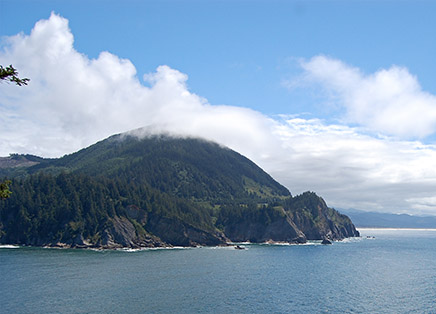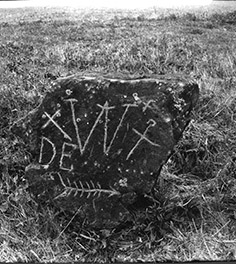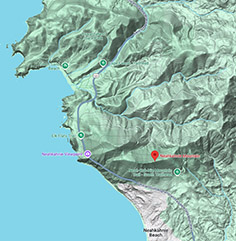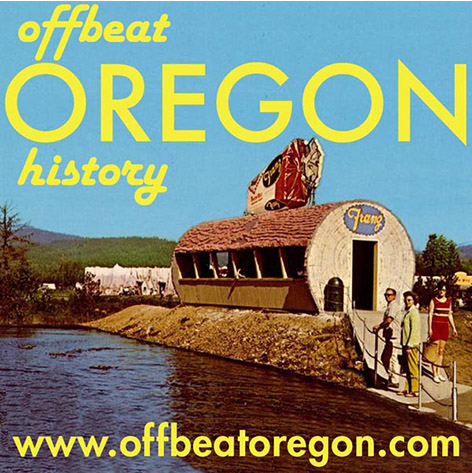NEHALEM BAY, TILLAMOOK COUNTY; 1800s:
The legendary lost gold
of Neahkahnie Mountain
By Finn J.D. John
|

(One other treasure hunter was drowned in 1990 looking for treasure on the rocky rim using an inflatable rubber raft to scout from the water.) When power equipment became available, things started to get serious. Treasure hunters brought bulldozers, backhoes, and other heavy equipment out on the beach and up on the side of the mountain, most of which was by now part of Oswald West State Park. As the treasure story’s fame grew, crackpots started coming to the scene with dowsing rods and marked-up Bibles that they claimed predicted the treasure’s location. One convinced himself, and never stopped trying to convince others, that the Ark of the Covenant was buried there. Meanwhile, by the late 1960s the state of Oregon was getting worried about environmental damage and potential impacts on other park visitors, who didn’t come to the beach to play around bulldozers and open pits. Clearly some control was needed. So in 1967 the state passed the Treasure Trove Law to allow people to dig for treasure on public land if they applied for a permit first. Unfortunately, the law didn’t define a “treasure trove,” so it basically turned a treasure-trove permit into a license, similar to a mining claim, allowing a treasure hunter to dig for almost anything while keeping other park visitors out. Even worse, the law claimed half of whatever a treasure hunter found for the state. This, of course, made the state look like it was just another claim jumper horning in, calling dibs from the sidelines in hopes of reaping where it had not sown. Essentially, the state lost the moral high ground, and when state agencies tried to limit what treasure hunters could do, they reacted as if the state were an untrustworthy business partner reneging on their deal. But the law was really unworkable, especially as it became increasingly clear to academics and state agencies alike that giving treasure hunters carte blanche to loot Indian burial sites and other archaeologically important places in the name of “hunting for a treasure trove” was a really bad idea. To make matters worse, the more serious treasure hunters — the ones with Ditch Witches and backhoes and bulldozers — tended to have aggressive and entitled attitudes about their supposed rights. They behaved like gold miners responding to claim jumpers. It became very clear that many, possibly even most, of them did not consider the state to have any moral authority to interfere with their operations, and would only follow the law when forced to do so by constant enforcement.
It seems that back in 1811 a fur trapper named Thomas McKay — father of Indian scout Donald McKay, of Oregon Indian Medicine Co. fame — arrived in Astoria on the Astorian Party’s ill-fated sailing ship Tonquin. According to the story related by Samuel Clarke, several years later, after the Hudson’s Bay Co. had bought out Astor’s operations and taken over as McKay’s employer, McKay was out trapping and trading one day when he met an old Indian woman who told him she, as a little girl, had been one of those Natives peering through the bushes at those strange bearded Spaniards. When he asked her to, she took him right to the spot and pointed it out. A few weeks or months later, back at Hudson’s Bay headquarters at Fort George, a rumor started getting around that McKay had found the by-now-famous Neakahnie treasure. How the cat got out of the bag is unclear; perhaps McKay was spending a suspicious amount of time on the mountain. “He must have dug for it, as the Hudson’s Bay Company people heard that he did so, so sent for him and placed him under rigid examination,” Clarke writes. “It seems that the company claimed that all their people discovered or found when in their service was the Company’s property. Tom couldn’t be blamed if he did not think so.” Then one day he walked away from the mountain, quit his job and disappeared. Years later, when he settled at French Prairie by the Willamette River, he seemed oddly flush with cash. “He was a generous fellow and always had money to spend and to give away,” Clarke writes. “So much so that when he afterward settled on French Prairie, he lived so well and was so liberal to all in need, that people believed that he had surely found that treasure and gloried that he made such good use of it.” And remember, this was before the 1848 gold rush, when other residents of the Willamette Valley were using bushels of wheat and “Abernethy rocks” as currency. Could it be that Thomas McKay found that chest, secretly slipped away with it, quit his job and went somewhere else to enjoy it, free of the notoriety and envy that always seem to accompany found money? In fact, isn’t that that what any of us would do?
|




